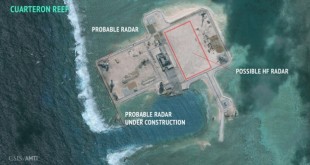The release of the Joint Doctrine for Cyberspace Operations by the Chief of Defence Staff (CDS) marks a significant milestone in India’s defense strategy. As global warfare increasingly shifts towards the digital domain, this doctrine reflects India’s commitment to integrating cyberspace into national security planning. The doctrine arrives at a crucial time when the Indian government is working on rolling out theatre commands, making the alignment of cyberspace operations with these commands essential for modern military effectiveness.
Understanding Cyber Threats and the Nature of Cyber Warfare
Modern cyber warfare extends beyond traditional hacking and espionage—it is now a key component of hybrid warfare strategies used by nation-states, terrorist groups, and cybercriminal organizations. Cyber threats have the potential to disrupt military communications, disable critical infrastructure, and manipulate information to influence public opinion and political stability.
Another major threat is critical infrastructure attacks, where adversaries target power grids, financial institutions, telecommunications networks, and water supply systems to cripple national economies and disrupt essential services. The 2015 Ukraine power grid attack, attributed to Russian cyber actors, demonstrated the catastrophic potential of such operations.
State-sponsored cyber attacks are among the most serious threats, with countries such as China, Russia, and North Korea engaging in sophisticated cyber campaigns that target adversary governments, military assets, and economic institutions. Cyber-enabled espionage and intellectual property theft pose long-term strategic risks, particularly for nations like India that are investing in indigenous defense technologies. Foreign adversaries use malware, phishing campaigns, and insider threats to infiltrate research organizations, compromising national security projects.
Disinformation campaigns and psychological warfare are increasingly being used as tools of cyber warfare, where adversaries manipulate public opinion, spread propaganda, and influence political processes through social media and deepfake technologies. The Russian interference in the 2016 U.S. presidential election is a prime example of how cyber operations can be weaponized to shape geopolitical outcomes.
In addition to state actors, cyber terrorism is a growing concern, as terrorist organizations use cyber tools to spread propaganda, recruit members, and execute cyberattacks on critical infrastructure.
Another major threat is supply chain attacks, where advanced persistent threat (APT) groups exploit vulnerabilities in software and hardware supply chains, leading to widespread cyber infiltration. The SolarWinds cyberattack in 2020, which compromised multiple U.S. government agencies and private corporations, showcased the vulnerabilities of interconnected digital ecosystems.
Additionally, disinformation and psychological warfare have emerged as significant challenges, with the use of deepfakes, bot networks, and AI-driven propaganda aimed at undermining national security and public trust in democratic institutions. Furthermore, the threat of zero-day exploits remains a pressing issue, as adversaries develop and deploy undiscovered software vulnerabilities before security patches can be applied, leading to large-scale cyber breaches.
How the Doctrine Addresses These Threats
The Joint Doctrine for Cyberspace Operations recognizes that cyber threats are no longer confined to the civilian sector; they have become an integral part of modern warfare. To counter these threats, the doctrine emphasizes seamless integration of cyber operations with military planning, ensuring real-time coordination between land, air, sea, and cyberspace domains.
One of the key aspects of the doctrine is its emphasis on cyber resilience. This includes strengthening India’s cyber defenses through robust encryption protocols, network segmentation, and real-time threat intelligence sharing. By adopting advanced cybersecurity measures, the doctrine aims to mitigate the risks posed by cyberattacks on critical infrastructure and military networks.
To counter cyber espionage and intellectual property theft, the doctrine promotes enhanced cyber surveillance and counterintelligence measures. This involves continuous monitoring of government and defense networks, strict access control mechanisms, and AI-driven anomaly detection systems to identify and neutralize potential cyber threats before they escalate.
The doctrine also highlights the importance of developing both defensive and offensive cyber capabilities. While strengthening cyber defenses against external threats, India is expected to develop offensive cyber capabilities for deterrence and retaliation, similar to leading cyber powers.
Proactive intelligence-gathering is another key focus, ensuring that cyber threats are identified before they escalate into full-scale attacks. The doctrine calls for enhanced cyber intelligence and threat-hunting capabilities to stay ahead of adversaries.
The doctrine also underscores the need for cyber warfare training and capacity building within the armed forces. By integrating cybersecurity training modules into military education programs, the Indian defense establishment aims to develop a skilled cyber workforce capable of handling evolving threats. This initiative will be crucial in preparing military personnel for complex cyber operations, including penetration testing, forensic analysis, and cyber deception strategies.
Additionally, it recognizes the critical role of private cybersecurity firms, startups, and universities in enhancing cyber resilience, encouraging collaboration with the private sector and academia. Given that a significant portion of India’s critical digital infrastructure is managed by private entities, collaboration between government agencies, defense organizations, and the private sector is essential for building a resilient cyber ecosystem. Initiatives such as information-sharing platforms, joint cybersecurity drills, and investment in indigenous cybersecurity startups will be key enablers in this regard.
Emerging technologies such as AI-driven cybersecurity tools and post-quantum cryptography are also emphasized as key enablers of next-generation cyber defense.
Lastly, the doctrine aligns India’s cyber strategy with its broader theatre command structure, ensuring that cyber operations are fully integrated into joint military planning and execution. This will enable the armed forces to conduct coordinated cyber campaigns in tandem with conventional military operations, thereby enhancing India’s overall strategic deterrence capabilities
Comparing India’s Cyber Doctrine with Global Cyber Strategies
As cyber warfare becomes a dominant battlefield, nations worldwide have developed dedicated cyber doctrines to secure their digital frontiers. India’s doctrine shares similarities and differences with global cyber defense strategies.
United States – USCYBERCOM & National Cybersecurity Strategy
The U.S. Cyber Command (USCYBERCOM) follows an active cyber defense approach, which includes offensive cyber operations against adversarial networks. The U.S. has integrated cyber capabilities into its broader national security strategy through policies such as Defend Forward, which proactively disrupts cyber threats before they reach U.S. networks. U.S. Cyber Command (USCYBERCOM) plays a key role in preemptive cyber strikes and countermeasures. In contrast, India’s doctrine is more focused on integration within the military structure and does not explicitly advocate offensive cyber operations at a global scale.
Additionally, strong public-private partnerships play a crucial role, with cybersecurity firms like FireEye, CrowdStrike, and Microsoft actively collaborating with the government to enhance national cyber defense.
Russia – Hybrid Warfare and Disinformation
Russia’s cyber doctrine heavily emphasizes information warfare, employing cyber operations alongside disinformation campaigns. Russian cyber units have been linked to election interference, infrastructure attacks, and cyber-espionage. While India’s doctrine recognizes the role of cyber operations in influencing narratives, it does not currently prioritize large-scale disinformation tactics in military doctrine.
China – People’s Liberation Army Strategic Support Force (PLA-SSF)
China integrates cyberspace into its overall military strategy through the Strategic Support Force (SSF), which combines cyber, electronic, and space warfare capabilities. The Chinese approach to cyber warfare is heavily focused on persistent cyber espionage campaigns, targeting governments, businesses, and research institutions worldwide.
The Great Firewall plays a crucial role in controlling domestic cyberspace and preventing external influence. Additionally, China maintains close integration between military cyber operations and state-backed tech companies such as Huawei and Tencent, leveraging them for cyber intelligence and infrastructure development.
China’s Integrated Network Electronic Warfare doctrine treats cyberspace as an essential component of modern warfare. The Chinese military, through the Strategic Support Force (SSF), combines cyber, electronic, and space warfare to gain information superiority. India’s doctrine acknowledges the evolving nature of cyber threats but does not yet integrate cyber and electronic warfare at the level seen in China’s approach.
Israel – Cyber Offensive & Defense Strategy
Israel is one of the most advanced cyber powers, with a doctrine heavily focused on offensive cyber capabilities. The Israeli Defense Forces (IDF) and Unit 8200 conduct aggressive cyber operations to neutralize threats before they materialize. A strong partnership between the government and private-sector cybersecurity firms has made Tel Aviv a global cybersecurity hub. Israel also follows a preemptive cyber warfare strategy, launching cyberattacks to disable adversary capabilities before conflicts escalate, ensuring that threats are neutralized in their early stages.
United Kingdom – National Cyber Force (NCF)
The UK has unified its military and intelligence cyber capabilities under the National Cyber Force (NCF), combining efforts from MI6, GCHQ, and the Ministry of Defence. The UK’s doctrine prioritizes cyber deterrence through active threat monitoring and intelligence-sharing with allies, ensuring that emerging cyber threats are addressed collaboratively. Additionally, a strong emphasis is placed on resilience-building, ensuring that both public and private sectors adopt robust cybersecurity frameworks to withstand cyberattacks.
The Future of India’s Cybersecurity Strategy
The Joint Doctrine for Cyberspace Operations lays a solid foundation for integrating cyber capabilities into India’s national security. However, the success of this initiative will depend on further developments. Establishing a dedicated Cyber Command is a crucial next step. Currently, India’s Defence Cyber Agency (DCA) is responsible for military cyber operations, but the doctrine could serve as a stepping stone toward upgrading it into a full-fledged Cyber Command, similar to USCYBERCOM. Strengthening offensive cyber capabilities is also essential to deter adversaries, ensuring that India develops cyber weapons capable of disrupting enemy networks and communications infrastructure.
Investing in indigenous cybersecurity research and development will be key to maintaining technological superiority. Accelerated research into AI-driven cybersecurity, post-quantum cryptography, and cyber deception technologies will enhance India’s defensive and offensive cyber capabilities. Enhancing cyber workforce training, developing indigenous cyber weapons, and integrating artificial intelligence (AI) in cyber operations will be crucial for strengthening India’s cyber resilience.
Additionally, India must enhance public-private partnerships in cybersecurity, fostering collaboration between government agencies, defense organizations, and private tech firms. Expanding international cyber diplomacy is another critical factor. Enhancing collaboration with global allies, including the U.S., Japan, and Israel, will enable India to share intelligence, conduct joint cyber exercises, and develop best practices in cyber warfare.
Conclusion
The release of the Joint Doctrine for Cyberspace Operations represents a significant step in India’s military modernization. As cyber warfare continues to evolve, India’s ability to integrate cyberspace operations with conventional military strategy, strengthen cyber resilience, and develop advanced offensive capabilities will be critical in safeguarding national security. By learning from the cyber doctrines of other major powers and leveraging its own technological and strategic strengths, India can establish itself as a formidable cyber power in the global arena.
 International Defense Security & Technology Your trusted Source for News, Research and Analysis
International Defense Security & Technology Your trusted Source for News, Research and Analysis

